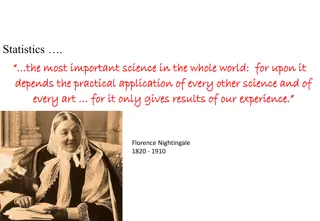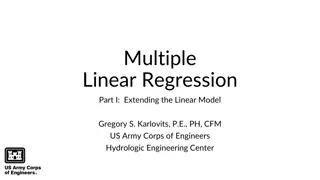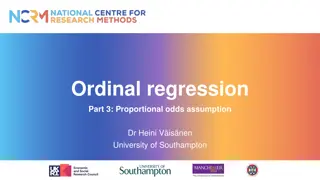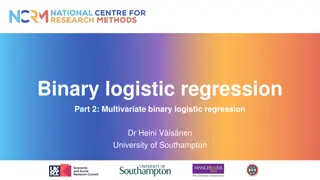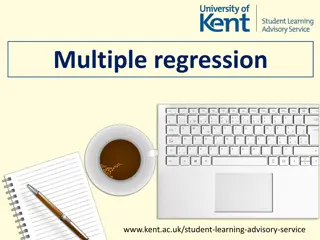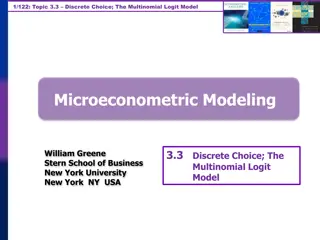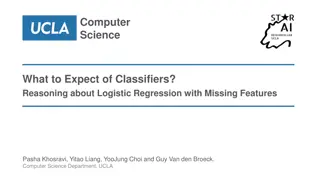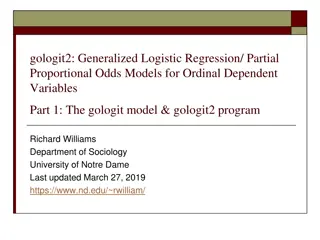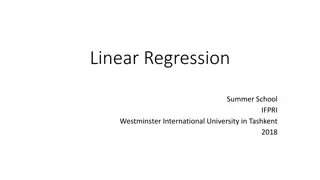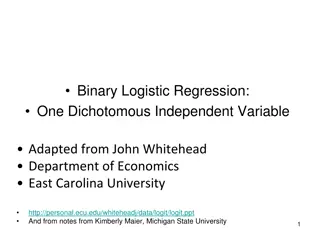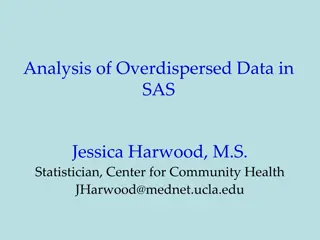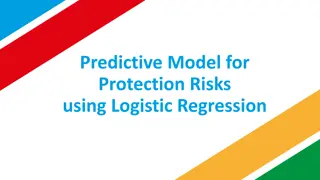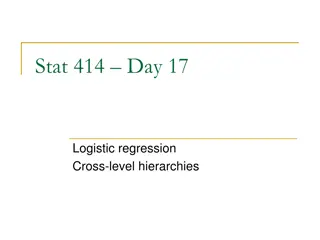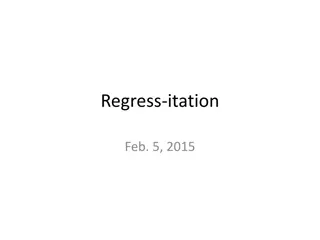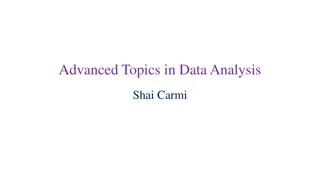Comprehensive Guide to Multiple Multinomial Logistic Regression with Dr. Heini V.
Learn about multinomial logistic regression models with multiple explanatory variables, including model selection, likelihood ratio tests, and Wald tests. Explore an example on the association between economic activity, gender, age, and marital status. Understand the distribution of variables like employment status, gender, age, and marital status. Follow step-by-step instructions to add age and marital status variables to the model.
Download Presentation

Please find below an Image/Link to download the presentation.
The content on the website is provided AS IS for your information and personal use only. It may not be sold, licensed, or shared on other websites without obtaining consent from the author.If you encounter any issues during the download, it is possible that the publisher has removed the file from their server.
You are allowed to download the files provided on this website for personal or commercial use, subject to the condition that they are used lawfully. All files are the property of their respective owners.
The content on the website is provided AS IS for your information and personal use only. It may not be sold, licensed, or shared on other websites without obtaining consent from the author.
E N D
Presentation Transcript
Multinomial logistic regression Part 2: Multiple multinomial regression Dr Heini V is nen University of Southampton
Outline Multinomial logistic regression model with more than one explanatory variable Model selection Likelihood ratio tests Wald-tests
Multiple multinomial logistic regression In the first video we only used one explanatory variable in our model However, in most applications we will want to control for other variables while examining the others I will show how to include, interpret and check the statistical significance of the variables in such situations
Example: the association between economic activity, gender, age and marital status Outcome economic activity has three categories 1. Economically inactive 2. Unemployed 3. In employment
Distribution of the variables Employment status N % Gender N % 442 39.32 516 45.91 Economically inactive Man 55 4.89 608 54.09 Unemployed Woman 627 55.78 In employment Total 1,124 100.0 Total 1,124 100.0 Data source: University of Manchester. Cathie Marsh Centre for Census and Survey Research. ESDS Government, ONS Opinions Survey, Well-Being Module, April 2011: Unrestricted Access Teaching Dataset [computer file]. 2nd Edition. Office for National Statistics. Social Survey Division, [original data producer(s)]. Colchester, Essex: UK Data Archive [distributor], October 2012. SN: 7146.
Distribution of the variables Age (years) N % Marital status N % 609 54.18 Married or cohabiting 89 7.92 16-24 388 34.52 25-44 243 21.62 Single 169 15.04 45-54 272 24.20 Widowed or divorced 184 16.37 55-64 Total 1,124 100.0 151 13.43 65-74 143 12.72 75+ Data source: University of Manchester. Cathie Marsh Centre for Census and Survey Research. ESDS Government, ONS Opinions Survey, Well-Being Module, April 2011: Unrestricted Access Teaching Dataset [computer file]. 2nd Edition. Office for National Statistics. Social Survey Division, [original data producer(s)]. Colchester, Essex: UK Data Archive [distributor], October 2012. SN: 7146. Total 1,124 100.0
Example: association between marital status and unemployment Outcome Marital status Single OR P-value When controlling for age and gender, married people have 82% lower odds (0.18 times the odds) of being unemployed rather than employed than single people. The pairwise association is significant (p<0.001) 1.00 Un- employed Married/ cohabiting Widowed/ divorced Single 0.18 <0.001 1.03 0.942 1.00 Eco- nomically Inactive Married/ cohabiting Widowed/ divorced 0.90 0.629 1.02 0.936
Example: association between marital status and unemployment Outcome Marital status Single OR P-value When controlling for age and gender, widowed or divorced people have 0.3% higher odds (1.03 times the odds) of being unemployed rather than employed than single people. The pairwise association is not statistically significant at any conventional level of significance. 1.00 Un- employed Married/ cohabiting Widowed/ divorced Single 0.18 <0.001 1.03 0.942 1.00 Eco- nomically Inactive Married/ cohabiting Widowed/ divorced 0.90 0.629 1.02 0.936
Interpretation using predicted probabilities exp(?1+ ????) ?1= 1 + exp ?1+ ??? + exp(?2+ ???) exp(?2+ ???) ?2= 1 + exp ?1+ ??? + exp(?2+ ???) 1 The reference category ?3= 1 + exp ?1+ ??? + exp(?2+ ???)
Calculating predicted probabilities Log-odds plugged into the formulae (see extract here) Usually software used, for instance margins command in Stata See computer workshop materials
Economic activity and marital status, probabilities for married men aged 25-44 years. exp( 1.36 1.69 ??????? 0.001 ???25 44) ??????= 1 + exp( 1.36 1.69 ??????? 0.001 ???25 44) + exp( 1.15 0.11 ??????? 0.89 ???25 44) exp( 1.15 0.11 ??????? 0.89 ???25 44) ??????= 1 + exp( 1.36 1.69 ??????? 0.001 ???25 44) + exp( 1.15 0.11 ??????? 0.89 ???25 44) 1 ?????= 1 + exp( 1.36 1.69 ??????? 0.001 ???25 44) + exp( 1.15 0.11 ??????? 0.89 ???25 44)
Interpretation using predicted probabilities Predicted probabilities of employment status by marital status for men aged 25-44. Employed Unemployed Inactive Married 86% 4% 10% Single 72% 18% 9% Divorced etc. 72% 19% 9% Married men aged 25-44 have a 86% probability of being employed. Both single and divorced/widowed men in this age group have 72% of being employed. Unemployment is the least likely among married men (4%) compared to almost a 20% probability among the other two groups.
Model selection How do we know which variables should be included in the model? Theory and background knowledge (as always). Likelihood ratio test.
Summary Multinomial regression used for categorical responses with 3 or more categories (that are not ordered) Interpretation can be conducted with log-odds, odds ratios or predicted probabilities like for any logistic model Odds can get tricky especially for dummy-variables due to multiple comparisons. Probabilities can be easier to understand, but need to hold other variables constant at certain values.


